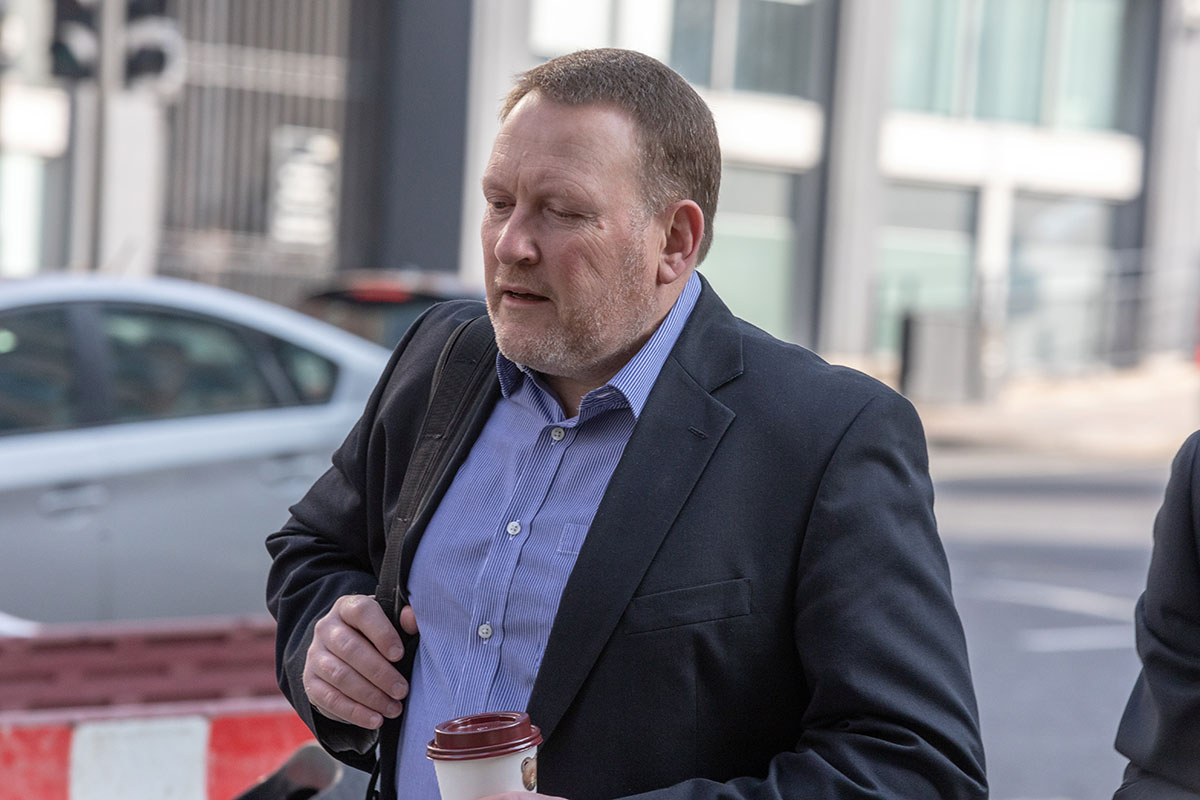Official told safety campaigner to ‘show me the bodies’ when warned of tower block fire disaster, inquiry hears
The official responsible for guidance on fire safety told a prominent architect to “show me the bodies” when he advised him to tighten standards to avert a tower block disaster, the Grenfell Tower Inquiry heard today.
Brian Martin, who was responsible for official guidance contained in Approved Document B in the years before the Grenfell Tower fire, denied using the phrase. He said that while he was “known for using plain English”, that was “a bit plainer than I would have said”.
The alleged comments were a reference to the lack of demonstrable evidence for tighter fire safety rules in a context of falling fire deaths.
This figure – which research attributes to factors such as increasing smoke alarm use and lifestyle changes such as the fall in smoking and chip pan use – has long been used as a justification by ministers for not changing fire safety rules.
Sam Webb, an architect who has campaigned for tighter rules on fire safety in tower blocks since the Ronan Point disaster in 1968, said in a witness statement shown to the inquiry today that he had met Mr Martin at an event in the Houses of Parliament in February 2016.
He claimed that he told Mr Martin that if Approved Document B was not reviewed, then another fire like the 2009 Lakanal House blaze was “inevitable” and risked multiplying the six fatalities in that fire by a multiple of “10 or 12”.
“Brian Martin’s reply to me was: ‘where’s the evidence, show me the bodies’,” his statement added.
Mr Webb added that Arnold Tarling, a chartered surveyor who was also campaigning for Approved Document B to be reviewed at this time, also heard Mr Martin used the phrase.
Mr Martin said that he recalled the conversation with Mr Webb but that he would not have used this phrase. “What I was trying to explain to him is, it would be difficult to justify raising standards given that what we’re actually experiencing was a regular reduction in the number of fire deaths,” he said.
“I mean, government policy had progressively hardened over quite an extensive period… I think the prime minister described people like me as an enemy of enterprise. Safety campaigners like Mr Webb have a view on how the world should be, but the government was in a very different place at the time.”
“Can you explain why it took the Grenfell Tower fire in which 71 people were killed on the night for the hazards posed by [aluminium composite material (ACM)] cladding to be fully appreciated?” asked Richard Millett QC, counsel to the inquiry.
“I think it’s the progressive decay in the construction industry, progressive decay that went alongside it in the building control world, the impact of government policy on regulation and the resources available to try and address these risks,” Mr Martin replied.
He accepted that there were “opportunities I missed to try and address this and that’s something I regret in a way I find difficult to describe”.
Mr Martin was also asked today about an email he was sent in February 2016 from cladding fabricator Nick Jenkins, which warned of “grave concern” that the number of buildings in the UK with ACM cladding were “many and growing”.
This followed Mr Martin assuring his seniors that a huge ACM fire, like those seen by this point in the Middle East, “shouldn’t be a problem in the UK” because there were ““provisions in the building regulations designed to prevent this”.
He had already been warned by industry figures that the guidance was in fact “not clear” on this point and that it required clarification.
Asked about the warning from Mr Jenkins, he said: “I’m not sure if I’ve really picked up on that at the time. I think I seriously underestimated the hazard associated with polyethylene-cored ACM and panels.”
“Why? Why did you underestimate the risk, given what you had observed and remarked a number of times about the Dubai fires?” asked Mr Millett.
“It’s very difficult to understand what’s actually happening with the fire by looking at press reports. Sometimes, the most innocuous fires are the ones that kill more people. So seeing a photograph of a building in another country on fire doesn’t necessarily give you an understanding of the true hazard,” he said.
Mr Martin accepted that the lack of fatalities in these Dubai fires “probably did colour my perception of the hazard”.
He added that he did not pick up on Mr Jenkins’ reference to “grave concern” because of “some of the hyperbole that people used” when contacting him about risks.
Asked why he did not issue a circular or a ‘frequently asked question’ to confirm that ACM panels should not be used, he said: “I think at this time, we really struggled to get anything done within the department.
“There was a lot of pressure on the team in relation to deregulation and so on… Once we got past the 2015 election, [there was] an even greater ambition towards deregulation.
“Regulation was a dirty word and there was so much political disruption, it was very difficult to get any kind of traction.”
Asked why he did not escalate the warning to his seniors in the department, he said: “It’s difficult to know what was going on in my head at the time. It was certainly an extremely frustrating period. And I think that had affected me in some way, which I find difficult to explain. But I think I’d got to the point where I was just focused on ‘let’s get this next review going and then we can we can look at this properly’.”
Just a week after receiving the emails from Mr Jenkins, Mr Martin was contacted by an engineer who raised the Dubai fires. He asked whether there was “a risk of anything like that happening here” and suggested producing “an alert”.
Mr Martin replied, telling him that “if people are getting things right, we shouldn’t see a similar incident here”.
Asked if this email showed Mr Martin “misleading” the engineer, he said: “I’ve never deliberately set out to mislead anybody.”
As the inquiry has seen, Mr Martin would go on to attend a meeting with the Centre for Window and Cladding Technology in March 2016, which followed up from a July 2014 email which had warned him that the guidance covering ACM was “not clear”.
Minutes of the March 2016 meeting show delegates agreeing that the guidance was “poorly written and open to interpretation” on the subject of ACM, with the passage intended to cover it given a “misleading” title which suggested that its application was limited to insulation. The minutes say that Mr Martin planned to change this when the document was next issued.
“I think we can take it that you didn’t after [this meeting] make any senior official or minister aware that you had accepted that an important section of the statutory guidance in place for almost a decade was misleading and had been the subject of a difference [of opinion] across the industry for some time?” asked Mr Millett.
“Not specifically. I certainly expressed a lot of frustrations that an approved document which was now well past the point which it ought to have been reviewed still needed to be reviewed. But I didn’t focus on this particular issue,” said Mr Martin.
Later, Mr Martin was asked about an industry guidance document published by the National House Building Council in July 2016, which suggested that ACM panels could be used on tall buildings, provided they had a Euroclass B rating – even in cladding systems that combined them with combustible insulation.
Asked why he did not challenge the document, Mr Martin said he “presumed there had been some testing” that systems comprising ACM panels had passed, to justify the guidance note.
This was despite Mr Jenkins telling him in his email just a few months earlier that no such tests had yet been carried out.
Today Mr Martin was also asked about a separate issue that has attracted much attention at the inquiry: official guidance published with the backing of government in 2011 that said it was “usually unrealistic” to prepare evacuation plans for disabled residents of blocks of flats.
This has been a deeply controversial issue at the inquiry, which has previously heard that 41% of the disabled residents of Grenfell Tower died in the fire.
Discussing the issue today, Mr Martin said it was not “practicable” to provide evacuation plans in general needs blocks of flats with no staff available to implement them, and providing such staff would be “too expensive” and “disproportionate”.
“So people die in their flats because they’re bed-bound, because it’s too expensive to have a system to get them out. Was that British government policy?” asked Mr Millett.
“That was what was considered at the time to be the prevailing reasonable approach to the problem,” said Mr Martin.
He continues giving evidence tomorrow.
Who is Brian Martin?
Brian Martin had been responsible for official building regulations guidance on fire safety, contained in Approved Document B, for almost 18 years by the time of the Grenfell Tower fire.
He was the person within the department “to whom others would turn” to answer questions on this topic.
When she gave evidence, Melanie Dawes, the former permanent secretary at the Department for Communities and Local Government (DCLG), was asked if it was “pretty dangerous” to have the responsibility for all this “falling on one man’s shoulders”.
“Yes, I do. I think it ’s a single point of failure that had been allowed to be created,” she said. Asked to explain how this happened, she said it reflected budget cuts, the localism agenda and the fact that “regulation was not seen as something valuable, it was seen as something that created costs and burdens”.
Mr Martin has no formal fire safety or engineering qualifications. His qualifications amounted to a diploma in building control surveying obtained around 25 years ago.
He had trained as a joiner and carpenter after leaving school, before rising to site manager. Asked if this gave him any fire safety experience, he said: “I would have installed some fire doors.”
Aged 22, he became a building control surveyor, working first for Westminster, Tower Hamlets and Dartford councils, and did review fire strategies for some complex projects, including the Bluewater shopping centre in Kent.
In 1999, he applied for a job at the Building Research Establishment (BRE), the former national testing centre which had recently been privatised. The BRE had a contract to support the government with a review of Approved Document B and within weeks of starting, Mr Martin was seconded to the department’s offices for two to three days a week to support this work.
Mr Martin would go on to take a permanent role at the department in 2008 as ‘principal construction professional’. This saw him take on primary responsibility for Approved Document B. The inquiry has already heard about many critical warnings regarding the looming danger of a cladding fire which were issued to him in this role.
In November 2017, five months after the Grenfell fire, he was promoted to head of technical policy, leading the team of specialists who oversaw changes to building regulations and guidance.
However, in September last year he moved to the planning directorate. He said he had been “encouraged” to find a new role given “the challenges associated with my attendance at the inquiry and the attention I was getting in the press”.
Sign up for our weekly Grenfell Inquiry newsletter
Each week we send out a newsletter rounding up the key news from the Grenfell Inquiry, along with the headlines from the week
Already have an account? Click here to manage your newsletters













